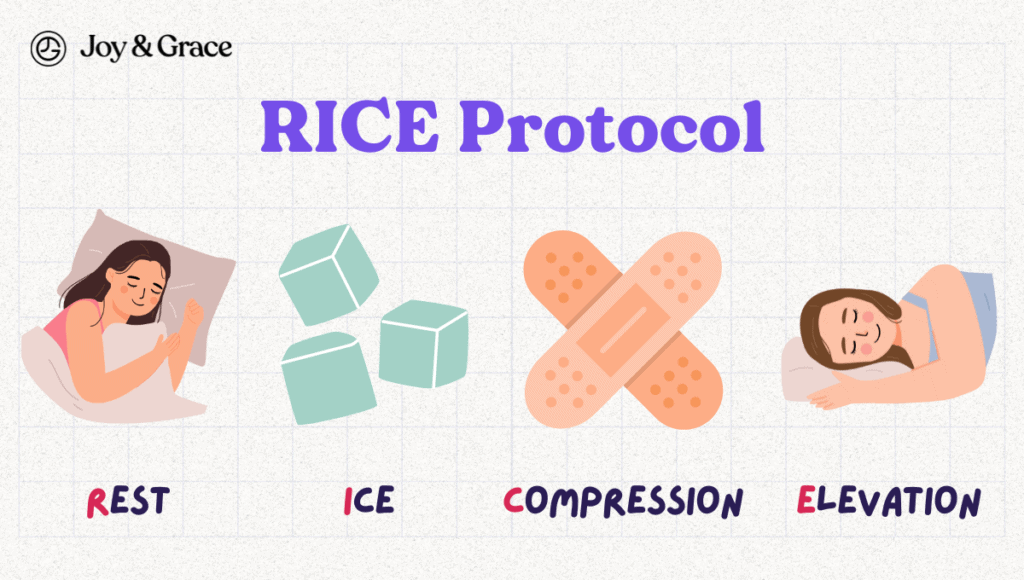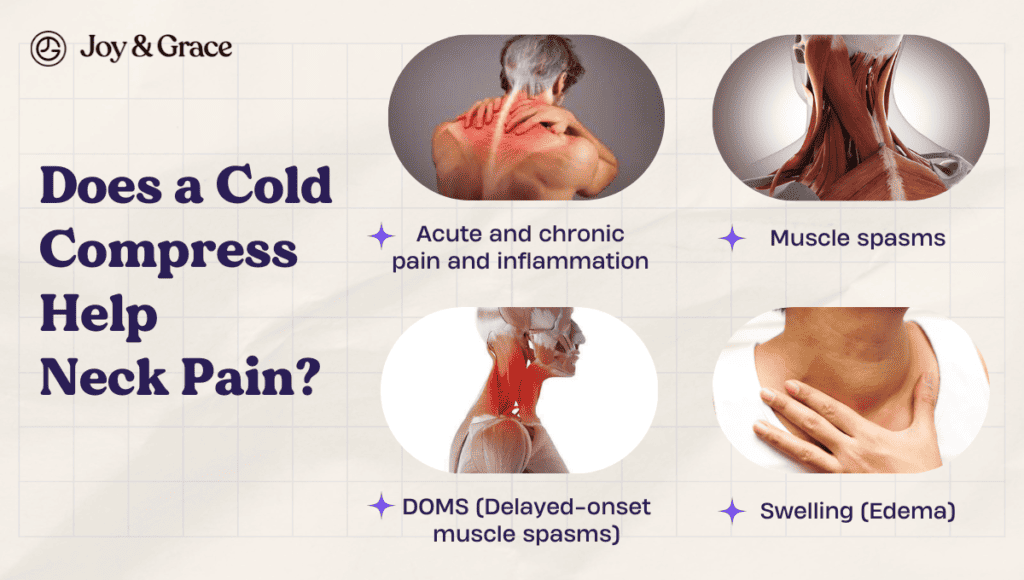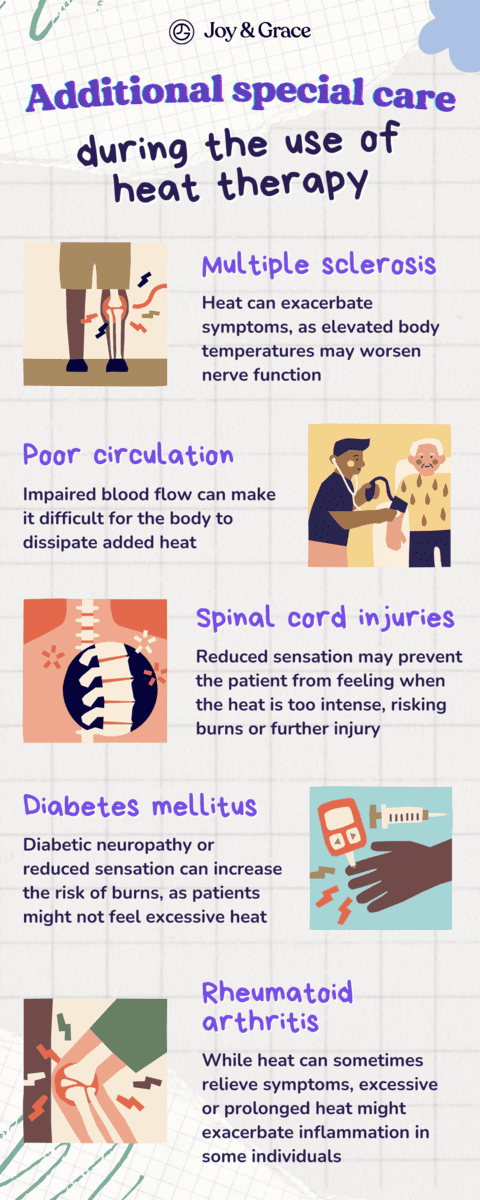Dealing with neck pain often feels like a hard knot of frustration and discomfort. If you’re experiencing neck pain, we understand you’re probably seeking the quickest way for relief. This is where hot and cold compresses may come in handy. But do they really work against neck pain? What compresses work better? How can you apply them? Let’s jump into the discussion and see for ourselves!
Should I Use Ice or Heat for Neck Pain?
Disclaimer: Always consult your doctor before turning to hot or cold therapies for neck pain.
Neck pain may have a wide range of causes. The best treatment is only possible with a tailored plan with several treatment methods.
Ice and heat can both be good options to ease your neck pain and discomfort. Hot and cold compresses have traditionally been used as neck pain therapy for ages. Not without reason, either! They’re affordable, widely available, and quite easy to use!
Ice and heat owe their pain-relieving abilities to their effects on metabolism and blood flow. But which is better for your neck pain? And which should you use first? Read on to find out.
Is a Heat Pad Better Than a Cold Pack?

In some cases, yes, a hot compress or pad may be better than a cold compress or pack. But, in other cases, the opposite holds! How can you know, then?
According to a 2015 article, heat may work better against neck pain and muscle soreness. Heat therapy increases blood flow and tissue healing, which may explain the effect on muscular neck pain.
On the other hand, cold therapy has been found to have positive effects when applied to the neck after acute injuries or trauma. It may effectively treat pain and inflammation by reducing
- Blood flow to the neck
- Metabolism
- Swelling
- Muscle spasms
- Tissue elasticity
Is Heat or Ice Better for Neck Muscle Pain?
Heat is deemed a better choice than ice for neck muscle pain, shoulder pain, and sore back pain. Cold therapy is more commonly applied to reduce inflammation from a neck injury or trauma.
Should I Ice or Heat First?
If you have a stiff or sore neck, try ice first and heat after. An icy, cold compress or pack may help reduce neck inflammation immediately. It also numbs the pain-processing nerve endings in the neck area. These effects can provide quick pain relief.
Heat, on the other hand, has the opposite effect as cold. It may be more effective a few days after the neck pain and inflammation have settled down.
You can also try alternating between heat and ice. For example, you can apply a hot compress to your neck for 15-20 minutes. Then, you can wait a few hours and apply a cold compress to your neck for 10-20 minutes. You may then repeat this cycle.
Remember: Don’t apply ice and heat to your neck at the same time! When used together, their effects may cancel each other out and provide no help whatsoever!
Cold Therapy: Does a Cold Compress Help Neck Pain?

Yes, a cold compress may indeed help with neck pain. Cold therapy represents the application of cold to reduce inflammation and relieve pain. Cold compresses are best for the treatment of acute injuries or trauma in the first 48-72 hours after injury.

They may also be incorporated for other conditions, such as:
- Acute and chronic pain and inflammation
- Muscle spasms
- DOMS (Delayed-onset muscle spasms)
- Swelling (Edema)
Using cold for treatment purposes is known as cold therapy or cryotherapy. Cold therapy basically involves removing heat from a body area like the neck. Cold therapy is commonly used as part of the RICE protocol. RICE is an acronym used to help doctors remember four helpful steps for acute injury management:
- Rest. Rest and protection of the injured or sore area can aid recovery. Avoid any activity that adds to your neck pain.
- Ice. As mentioned, a cold compress may decrease pain, inflammation, and swelling.
- Compression. Compression involves wrapping the injured neck with a tape or elastic bandage. Compression can ease swelling and improve life quality.
- Elevation. Elevating the painful area with a pillow above the level of the heart can help minimize swelling.
Cold compresses, on the other hand, may come in two forms:
- A cold (ice) pack
- A cold pad or towel
These options are easy and quick to arrange. Let’s see how.
Can I Put an Ice Pack on My Neck for Neck Pain Treatment?
Yes, you can! Moreover, you can do it at the convenience of your home. To arrange a cold or ice pack:
- Put some ice cubes in a plastic bag.
- Fill the bag of ice partially with water.
- Seal the bag.
- Cover the bag with a damp cloth.
- Put the bag on your painful neck.
To make a cold pad or towel:
- Soak a clean cloth or towel in cold water.
- Wringle it out and fold it into a roll
- Put it on your neck and hold it there
How Long to Use Ice Pack for Neck Pain?
You can apply an ice pack to your neck for 10-20 minutes at a time. Don't forget to remove it after that, though. Additionally, ice shouldn’t touch the skin directly, as it can damage it by causing frostbite. Always ensure you cover the pack with a damp cloth.
How Many Times Should I Ice My Neck?
Apply an ice or cold compress to your neck at least three times a day for as long as the pain lasts. You can go by the following routine:
- Day 1:
Apply ice for 10 minutes once every hour during your waking hours. If you're awake for, say, 16 hours a day, you can apply the ice 16 times.
- Day 2 and 3:
Apply ice for 10 minutes every 2-3 hours while awake. For example, 16 waking hours translates to 5-8 daily applications.
- After the initial three days:
Use the ice for 15-20 minutes, specifically three times a day. This amounts to a total of three sessions: in the morning, in the afternoon, and before bed.Additionally, you can apply the compress after any strenuous activity or exercise.>>>
Hot Compress: What is Heat Therapy for Neck Pain?
Heat therapy involves applying heat to the body and increasing its temperature. A heat compress represents one of the types of heat therapy that can be used as a heat pack or towel.
Other heat therapy modalities may include:
- Hot water bottles
- Electric heat pads
- Heated stones
- Soft-heated packs filled with grain
- Hot baths
- Sauna
- Paraffin
- Steam
- Infrared heat lamps
What is Hot Compress Used for?
A hot compress is most commonly used for muscular pain. It works well to get rid of neck muscular tension and aches by increasing blood and oxygen flow. It also promotes the healing of tissues damaged by inflammation or strain.
A 2020 research study shows heat therapy may also be used as trigger point therapy. This means that heat can be applied to specific neck spots called trigger points. These spots are crucial to pain development. This application of heat may bypass the need for physical therapy or opioid medications in some people.
How Do You Make a Hot Compress for Neck Pain?

There are a few ways you can make and use a hot compress for neck pain at home. You may simply dampen a towel with warm water and apply it to your neck. A 2013 study tells us that a damp or moist towel may be more beneficial than a dry one against soreness.
Alternatively, you may use a microwaveable heating pad or compress. This type of compress needs to be warmed up in a microwave. Make sure to put it on a plate and then insert it in the microwave. Heat it for a few minutes, take it out, and carefully apply it to your neck.
Is Heat Therapy Safe?

Heat therapy is generally safe. But you may want to ensure you take the right measures to prevent unwanted effects. Your hot compress or heating pad shouldn’t be overheated. They should also be put carefully on your skin to avoid burns.
When Should I Not Use a Hot Compress?
Hot compresses should not be used in the first 48 hours after an injury. They may increase blood flow, thus potentially adding to the ongoing inflammation. Even without an injury, if inflammation is the root of your pain, it's best to avoid heat. Signs of inflammation (that also suggest you shouldn't use heat) include:
- Redness
- Heat
- Swelling
Additional special care should be taken during the use of heat therapy in patients with:
- Multiple sclerosis. Heat can exacerbate symptoms, as elevated body temperatures may worsen nerve function.
- Poor circulation. Impaired blood flow can make it difficult for the body to dissipate added heat, potentially leading to burns or tissue damage.
- Spinal cord injuries. Reduced sensation may prevent the patient from feeling when the heat is too intense, risking burns or further injury.
- Diabetes mellitus. Diabetic neuropathy or reduced sensation can increase the risk of burns, as patients might not feel excessive heat.
- Rheumatoid arthritis. While heat can sometimes relieve symptoms, excessive or prolonged heat might exacerbate inflammation in some individuals.
Remember, it's always important to consult with a healthcare professional before starting any new treatment or therapy.
Can I Use Hot Water for Neck Pain?
As said, hot water may help when your neck pain is muscular in origin. As we mentioned before, heat can loosen muscle tension, thus also relieving neck pain.
Nevertheless, do consult your doctor beforehand. If there’s inflammation present in your neck, you’d be better off not using hot water.
Is Hot Water or Cold Water Better for Neck Pain?
The answer to this question depends on the cause. So, “better” is rather a relative term. While hot water may provide relief from muscle pain, cold water may work better for injury-related pain.
Is Heat Good for Nerve Pain in the Neck?
Nerve pain in the neck may be caused by a pinched nerve coming out of the spinal cord. This condition is known as cervical radiculopathy. A pinched neck nerve may affect the neck, shoulder, and arm, causing:
- Numbness
- Tingling
- Weakness
- Loss of sensation
While heat might temporarily relieve nerve pain, it’s not necessarily the best solution. Seek your doctor’s opinion as early as possible to achieve the best outcome.
Causes of Neck Pain: What Are the Types of Neck Pain?
Neck pain is one of the most common musculoskeletal problems worldwide. It can result from various causes. Some of the most common include:
- Weak and overused neck muscles (poor posture, tense muscles, overuse injuries, etc.)
- Wear and tear on the cervical spine with age (cervical spondylosis)
- Whiplash injuries
- Narrowing of the vertebral canal or a herniated disk
According to how long it lasts, neck pain can be:
- Acute (the pain lasts for less than six weeks)
- Sub-acute (the pain lasts for 6-12 weeks)
- Chronic (the pain lasts for more than 12 weeks)
Diagnosing Neck Pain

As we mentioned, the first step to coming up with the correct diagnosis for your neck pain begins with your medical history. Your doctor will want to know about:
- The symptoms and the possible cause of your neck pain
- The duration of neck pain
- Potential “so-called” yellow flags
Yellow flags are psychosocial signs that point to a long-term illness or disability. They include things like- Belief that pain is harmful, resulting in avoidance and poor compliance with exercise.
- “Sickness behaviors” (like extended rest)
- Low or negative moods
- Social withdrawal, etc.
After taking your answers, the healthcare provider will physically examine your neck by checking the following:
- Posture, symmetry, muscle development, and previous injuries
- Tenderness when touching or palpating the neck
- The full range of neck movement
- Possible nerve damage
After a thorough physical exam, you may need to undergo some tests. These include blood tests for possible infections, imaging tests, and other tests.
Imaging tests are preferred if a neck injury is suspected. The most valuable imaging tests for neck pain are
- Plain Radiography (plain X-Rays)
- CT Scan
- MRI Scan
Treatment for Neck Pain: What is the Best Treatment for Neck Pain?

Treatment of neck pain depends on the cause and duration of the pain. Acute neck pain may resolve spontaneously. According to a study, more than a third of people with neck pain will still have low-grade symptoms or recurrent pain a year later.
Treatment of neck pain usually involves the use of medications. For mild neck pain, your doctor will usually prescribe Tylenol or Ibuprofen. Muscle relaxants and corticosteroid injections may be effective for more severe and chronic neck pain.
For better results against neck pain, medications can be combined with some form of activity or alternative treatment plan. The most useful activities for neck pain may include:
- Heat or ice therapy. Hot and cold compresses work better against neck pain in combination with painkillers and physical exercise.
- Physical therapy (Neck exercises)
- Manual therapy. This type of therapy involves “spinal manipulation.” This type of therapy relieves muscle tension and makes movement easier.
- Massage. Massage therapy relaxes your neck muscles and provides temporary pain relief.
- Acupuncture. This relaxation method is also widely used for many types of pain.
- Yoga. Yoga is a great activity as it may relieve pain and relax your body and mind.
- Tai Chi: Tai Chi is an activity that relaxes your neck, body, and mind and improves cardiovascular fitness.
To eliminate neck pain, you should also change some of your daily habits. Pay special attention to how you sit or sleep.
Surgery for neck pain is only rarely needed.
Exercises for Neck Pain
Physical exercise can be a crucial part of your treatment plan for neck pain. Exercise (combined with other therapies) can improve functionality and ease recovery.
Before you take up any sort of exercise, ask your doctor what suits you best. Effective exercises that you can try at home include the following:
- Head turn
Start by facing forward. Slowly turn your head to one side, as far as is comfortable for you. You should feel a stretch on the opposite side of your neck. Hold for two seconds and repeat on each side.
- Head tilt
Start by facing forward. Slowly tilt your head to one side, as far as is comfortable for you. You should feel a stretch on the opposite side of your neck. Hold for two seconds and repeat on each side.
- Forward head tilt
Start by facing forward here as well. Slowly touch your chest with your neck and bring it back to the starting position.
- Wide shoulder stretch
Place your arms at a right angle in front of your body. Your palms should be facing upward. Move your palms and forearms until they point out from either side of your body. Hold for a few seconds. Finish by bringing your arms back into the starting position.
Prevention of Neck Pain

How can you prevent neck pain from happening again? Here’s some helpful advice:
- Follow your treatment plan and your doctor’s advice.
- Pick a comfortable pillow and bedding.
- Avoid sleeping on your stomach.
- Use a headrest.
- Pay attention to your posture.
- Drink plenty of water.
- Carry weights evenly. For example, avoid putting a backpack only over one shoulder.
- Exercise and stretch your neck regularly and carefully.
- Keep your computer at eye level.
- Try to use your phone less.
When to See a Doctor

If your neck pain becomes persistent and doesn’t get better with therapy, pay your doctor a visit. You may also want to see your doctor if you experience any of the following symptoms:
- Fever, headache, and neck stiffness
These symptoms might indicate an ongoing infection such as meningitis, which requires prompt treatment.
- Pain traveling down the arms
Your hand or arm might be weak, numb, or tingling. These can be telltale signs of a herniated cervical disc.
- Loss of bowel or bladder control
This might mean compression of the spinal cord.
- Pronounced neck instability
If you can suddenly tilt your head forward or back much farther than usual, you might have a fracture or torn ligaments. An accompanying history of injury can support the diagnosis.
- Persistently swollen glands in the neck
Infection or a tumor can cause swollen glands and neck pain.
- Chest pain or pressure
A heart attack can result in neck pain along with more classic heart symptoms.
Takeaway
Ice and heat can both be good options to ease your neck pain and discomfort. They owe their pain-relieving abilities to their effects on metabolism and blood flow.
Heat may work better against neck pain and muscle soreness. Heat therapy increases blood flow and tissue healing, which may explain the effect on muscular neck pain.
Cold therapy has been found to have positive effects when applied to the neck after acute injuries or trauma.
Using cold for treatment purposes is known as cold therapy or cryotherapy. Cold therapy basically involves removing heat from a body area like the neck.
A cold compress may come in two forms:
- A cold (ice) pack
- A cold pad or towel
Ice shouldn’t touch the skin directly, as it can damage it by causing frostbite.
Apply an ice or cold compress to your neck at least three times a day for as long as the pain lasts.
Heat therapy involves applying heat to the body and increasing its temperature. A heat compress represents one of the types of heat therapy that can be used as a heat pack or towel.
Heat therapy is generally safe. But you may want to ensure you take the right measures to prevent unwanted effects. Hot compresses should also be put carefully on your skin to avoid burns.
Hot compresses should not be used in the first 48 hours after an injury.
If you have a stiff or sore neck, try ice first and heat after. An icy, cold compress or pack may help reduce neck inflammation immediately. Heat has the opposite effect as cold. It may be more effective a few days after the neck pain and inflammation have settled down.
You can also try alternating between heat and ice but don’t apply them to your neck at the same time.
Hot and cold compresses work better against neck pain in combination with painkillers and physical exercise.















